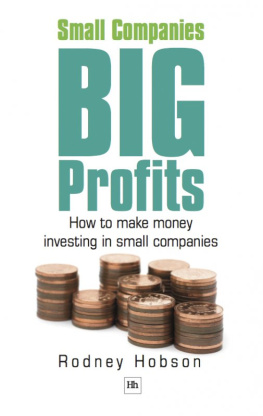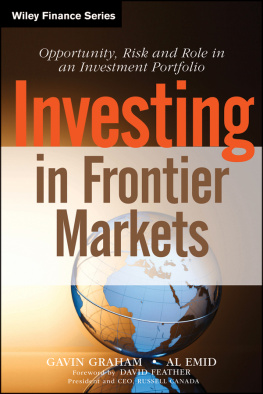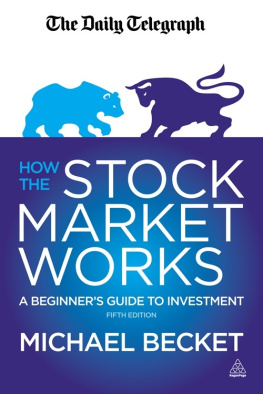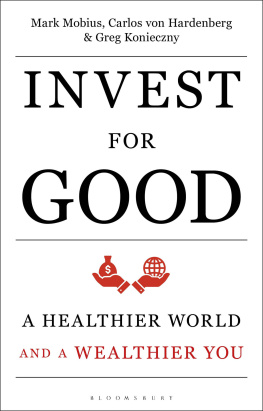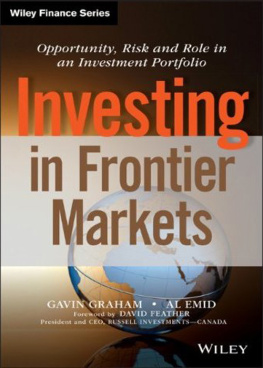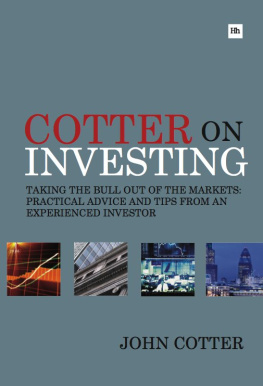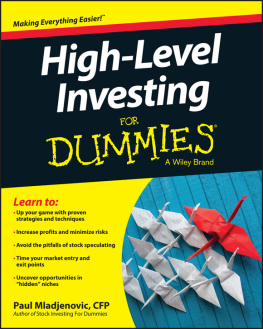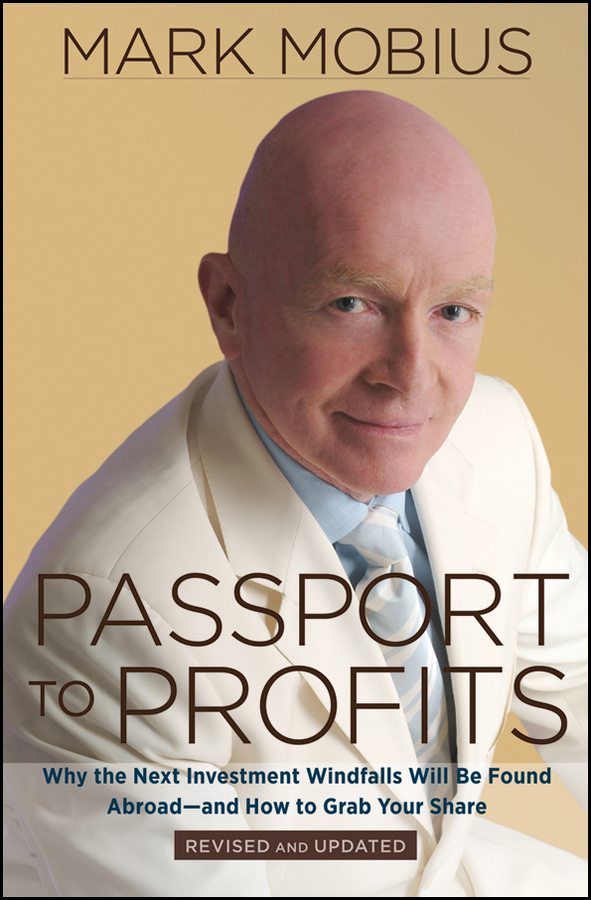Contents

Copyright 2012 John Wiley & Sons Singapore Pte. Ltd.
Published in 2011 by John Wiley & Sons Singapore Pte. Ltd., 1 Fusionopolis Walk, #07-01, Solaris South Tower, Singapore 138628
All rights reserved.
An earlier version of this book was published in hardcover by Texere Publishing in 1999. Business Plus published a paperback version in 2000.
No part of this publication may be reproduced, stored in a retrieval system, or transmitted in any form or by any means, electronic, mechanical, photocopying, recording, scanning, or otherwise, except as expressly permitted by law, without either the prior written permission of the Publisher, or authorization through payment of the appropriate photocopy fee to the Copyright Clearance Center. Requests for permission should be addressed to the Publisher, John Wiley & Sons (Asia) Pte. Ltd., 1 Fusionopolis Walk, #07-01, Solaris South Tower, Singapore 138628, tel: 6566438000, fax: 6566438008, e-mail: .
This publication is designed to provide accurate and authoritative information in regard to the subject matter covered. It is sold with the understanding that the Publisher is not engaged in rendering professional services. If professional advice or other expert assistance is required, the services of a competent professional person should be sought. Neither the author nor the Publisher is liable for any actions prompted or caused by the information presented in this book. Any views expressed herein are those of the author and do not represent the views of the organizations he works for.
Other Wiley Editorial Offices
John Wiley & Sons, 111 River Street, Hoboken, NJ 07030, USA
John Wiley & Sons, The Atrium, Southern Gate, Chichester, West Sussex, P019 8SQ, United Kingdom
John Wiley & Sons (Canada) Ltd., 5353 Dundas Street West, Suite 400, Toronto, Ontario, M9B 6HB, Canada
John Wiley & Sons Australia Ltd., 42 McDougall Street, Milton, Queensland 4064, Australia
Wiley-VCH, Boschstrasse 12, D-69469 Weinheim, Germany
Library of Congress Cataloging-in-Publication Data
ISBN 978-1-118-15384-0 (Paperback)
ISBN 978-1-118-15385-7 (ePDF)
ISBN 978-1-118-15387-1 (Mobi)
ISBN 978-1-118-15386-4 (ePub)
Preface
Why This Book? Why Now?
Heres the direct answer: To get the word out to investors who might want to venture into the emerging markets.
One of the great treats of being a successful fund manager is that people (who often recognize my Yul Brynneresque shaved head and noble visage from TV talk shows) are constantly cornering me in hotel lobbies and airport lounges, pumping me for scoops. Of course, even if I felt like passing on the occasional hot tipwhich I definitely do notethical and legal considerations would strictly forbid me from doing so.
So whats my blueprint, my road map, they ask, my method of picking the right regions, the right countries, the right companies at the right time?
How did I know to throttle down on Thailand before the baht crashed, to gear up in Russia just as it was preparing for liftoff, and to pull back in Russia before that market crashed?
Oh, its a long story. I shrug, hoping that will discourage them from asking for more.
But sometimes, some people actually want to hear the whole storyespecially during those long flight delaysfrom the buried treasures Ive dug up in some of the most unlikely places, from the Chilean mining-and-transport company Antofagasta, whose hidden asset turned out to be copper mines worth more than its railroad, to total turkeys like the Turkish utility looted by a locally powerful clan, who took the book on investor rights and tossed it in the trash, with total impunity.
Ill be celebrating my twenty-fifth anniversary at the helm of the worlds first listed emerging markets mutual fund in 2012. Just to give you an idea of the performance of emerging marketsfor the 24-year period ended March 31, 2011, our flagship Templeton Emerging Markets Fund (the first New York Stock Exchangelisted emerging markets fund) returned an average annual gain of 58.5 percent, allowing it to outperform our peers and the MSCI Emerging Markets index.
Wed beaten the indexes, wed beaten the averages, wed beaten the developed economies by buying up shares in companies few people had ever heard of, in countries even sophisticated investors had long been inclined to dismiss with a snobby sniff. In the roughly 25 years since the legendary Sir John Templeton took the twofold risk (one, of betting on emerging markets, and two, hiring me) to run his pioneering emerging markets fund, Id put in enough time on commercial flights to earn myself a number of frequent-flier first-class flights to the moon.
Id toured rubber plantations in Thailand and road-tested bikes over the pothole-ridden roads of rural China.
Id choked on roasted camels meat, sheeps eyeball, guinea pig, and dined (surprisingly well) on scorpions on toast.
Id hobnobbed with princes, potentates, and pashas, and been swindled in souks so labyrinthine Im still amazed I ever found my way out.
Id taken bone-jolting rides on mountain roads that would have turned my hair gray if I had any left to turn.
All to find undervalued companies before other investors do.
I think you could safely say that Im driven.
And I hope that by the end of this book, youll feel driven to take a few leaves out of it.

These days, I spend at least 300 out of every 365 days either on the road, or in the air. For most people forced to endure it, homelessness is the ultimate sacrifice. But its taken me many years of hard work to achieve the high status of full-time nomadan endangered species Ive long admired for their fierce independence, their refusal to abide by conventional norms, their desperate desire for freedom. Though some people probably pity me for having no home, no family, no domestic life to speak of, my somewhat eccentric lifestyle offers untold opportunities for variety, stimulation, and creativity.
With safety in mind our Franklin Templeton Group has forced me to use a Gulfstream IV private jet. This allows me to avoid unsafe airlines and frees me and my free-floating Templeton team from the countless hassles, inefficiencies, and rigidities of commercial travel.
Sure, Ive read studies that purport to show that private jets can be more economical for corporations than commercial flights. But more to the point, Im a little too familiar with the safety statistics relating to commercial flying in some of the regions of the world we routinely visit. In particular, Im thinking about Russia, China, and certain parts of Latin America. No offense, but with the amount of flying I do, the numbers are not in my favor.
So I genuinely appreciate the opportunity afforded me to fly in a plane that I can feel fairly sure offers a stronger safety record than the local airline. Its never easy assessing what a single life may be worth, but since I typically have four to five staffers aboard, the cost-benefit analysis improves considerably in favor of the personal plane.
If it makes any of you jet-less feel any better, our aircraft was acquired at a cut price by Templeton, where we make a religion of hunting down bargains.
Apart from the occasional overnight flight, I spend nearly every night of my restless life in hotels. I select these temporary homes away from home more on the basis of offering an up-to-date fitness center than any other single amenity. I do own apartments around the world, but theyre primarily for investment purposes.


